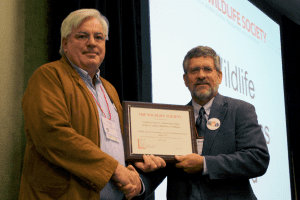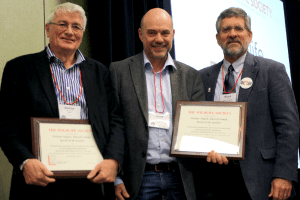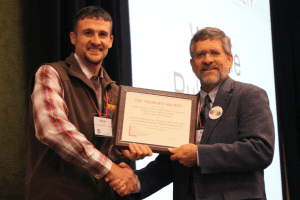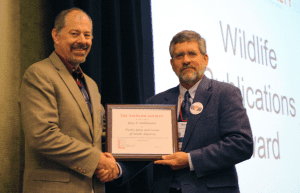Share this article
Four outstanding publications honored by TWS
The Wildlife Publication Awards are one of The Wildlife Society’s oldest awards, first presented in 1940, just three years after the Society’s founding. This award recognizes works of excellence in scientific writing characterized by originality of research or thought and a high scholastic standard in the manner of presentation. There are four categories of publications that are eligible to receive the award each year — book, edited book, article/journal paper and monograph.
The deadline to nominate publications for the 2016 Wildlife Publication Awards is March 1, 2016. Click here to review the criteria and to learn how to submit a nomination.
Ducks, Geese, and Swans of North America (book)
Authored by the late Dr. Guy Baldassarre, Ducks, Geese, and Swans of North America is the latest installment of a series of editions owned and conceived by the Wildlife Management Institute. The first edition, authored by Francis Kortright, was published in 1942, followed by editions two and three in 1976 and 1980, both authored by “Mr. Waterfowl,” Frank C. Bellrose.
After an almost 30-year hiatus, the Wildlife Management Institute decided it was time for a 21st century edition of the book. After much convincing by his editor, Vince Burke, Baldassarre finally agreed to take on the inconceivable task researching and writing Ducks, Geese and Swans of North America in 2008. He spent the next five years scouring the unimaginable mass of literature on all 46 types of waterfowl in North America, synthesizing everything that was known, and talking to experts across the continent.
“Guy, as anybody who knew him would attest, was a larger than life character. He filled every room he was in,” Burke said of his friend, who passed away at just 59 years old due to complications from chronic lymphocytic leukemia. “He had just a great passion for The Wildlife Society. He had a deep affection for his colleagues and being recognized in this way, I have no doubt, would have meant a tremendous amount to him.”
Burke stressed that no matter how important Baldassarre’s work was, no matter how many awards he won, the most important thing to him was family. The Wildlife Management Institute wrote: “There became notably less energy, intelligence and charisma in the wildlife profession and the entire world with the loss of Dr. Guy A. Baldassarre…”
Wildlife Science: Connecting Research with Management (edited book)
 With only behind the scenes help from co-editor Lenny Brennan, Wildlife Science: Connecting Research with Management was conceived, organized and put together by three graduate students — Steve DeMaso, Joseph Sands and Matt Schnupp.
With only behind the scenes help from co-editor Lenny Brennan, Wildlife Science: Connecting Research with Management was conceived, organized and put together by three graduate students — Steve DeMaso, Joseph Sands and Matt Schnupp.
“To my knowledge this kind of recognition for a book produced by graduate students is absolutely unheard of with respect to books that have won [Wildlife] Publication Awards from TWS,” Brennan said. “They did it. In spades. I am incredibly proud…”
The book gets to the core of a fundamental issue in not only wildlife science, but many fields of science — the disconnect between science and management practices. Until now, no other book had ever truly tackled the subject in such a comprehensive manner. While studying at the Cesar Kleberg Wildlife Research Institute, the grad students were taking a class in systems modeling and trying to develop a model that showed how research and management work together. The idea for the book came about when they were having a tough time finding logic examples that held up, such as supplemental feeding of quail, which research shows is a neutral management practice.
“There’s a lot of research out there that seems to not make its way into management practice, or managers tend to overlook things that have been confirmed or established with research,” Brennan said.
Evolutionary Consequences of Nonselective Harvesting in Density-Dependent Populations (article)
 Mostly theoretical and highly mathematic, Evolutionary Consequences of Nonselective Harvesting is based on a number of papers written in the 1990s about how to perform sustainable harvesting in fluctuating environments. The three authors (Steinar Engen, Russell Lande and Bernt-Erik Sæther) showed that in general the most sustainable harvesting strategies also were those expected to give the smallest permanent genetic changes in the population.
Mostly theoretical and highly mathematic, Evolutionary Consequences of Nonselective Harvesting is based on a number of papers written in the 1990s about how to perform sustainable harvesting in fluctuating environments. The three authors (Steinar Engen, Russell Lande and Bernt-Erik Sæther) showed that in general the most sustainable harvesting strategies also were those expected to give the smallest permanent genetic changes in the population.
Although the authors had confidence in their paper, they were surprised to win a Wildlife Publication Award due to its theoretical nature and pleased to see the Society’s interest in basic science. The paper required its authors to delve into two completely separate areas of biological research — quantitative population genetics and population dynamics — but their longtime experience in both fields made this possible.
“This is a fantastic experience after working almost 40 years on the border of stochastic modelling, statistics and biology,” said Engen, the lead mathematician on the project. “When you work in that way, people often claim that your research is neither good mathematics nor good biology. I obviously mean the opposite: interdisciplinary research is becoming more and more important, and different types of scientists have to learn more about how to work together in the future.”
Life-History Characteristics of Mule Deer: Effects of Nutrition in a Variable Environment (Monograph)
 Despite an emphasis on the importance of nutrition to ungulate populations, recent publications have lacked in representing the discipline of nutritional ecology relative to other topics, according to Kevin Monteith, lead author of the monograph. In analyzing a 13-year study, Monteith and six co-authors succeed in showing that nutrition is a revealing and tractable tool for both research and management.
Despite an emphasis on the importance of nutrition to ungulate populations, recent publications have lacked in representing the discipline of nutritional ecology relative to other topics, according to Kevin Monteith, lead author of the monograph. In analyzing a 13-year study, Monteith and six co-authors succeed in showing that nutrition is a revealing and tractable tool for both research and management.
“The conceptual and quantitative approach to a robust dataset yielded a comprehensive assessment of numerous theoretical and applied topics, some of which have either evaded or caused controversy among scientists and managers since Aldo Leopold’s time [e.g., carrying capacity, consequences of mortality],” said Monteith, crediting the foresight of the study’s coordinator, Dr. Vernon Bleich (California Department of Fish and Wildlife), with seeing the value in this type of long-term study.
Monteith became involved in the rare, intense, long-term study in 2006 when he was recruited by Bleich to lead the project by way of pursuing a Ph.D.
“Winning the [Wildlife Publication Award] from The Wildlife Society is a great honor, and while we are extremely grateful for receiving the award, we hope that the recognition serves to elevate the awareness of the work that it might impact science and management of large herbivores in the future,” Monteith said.









